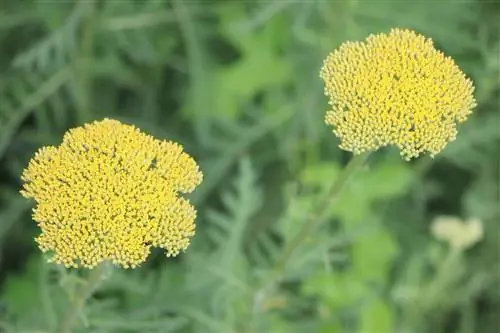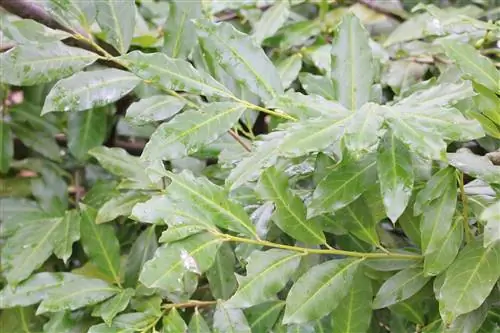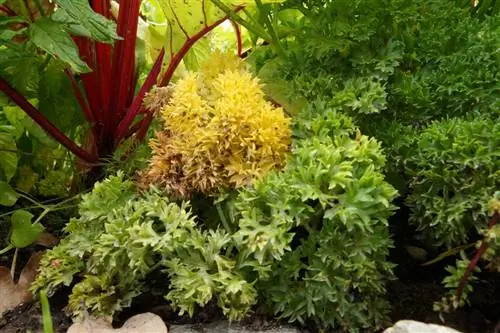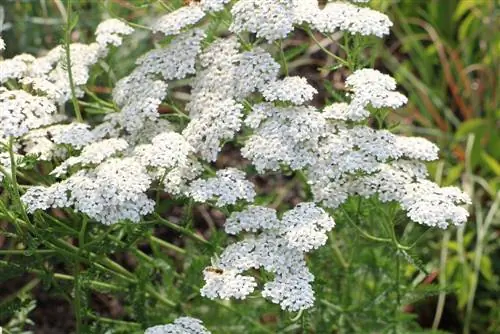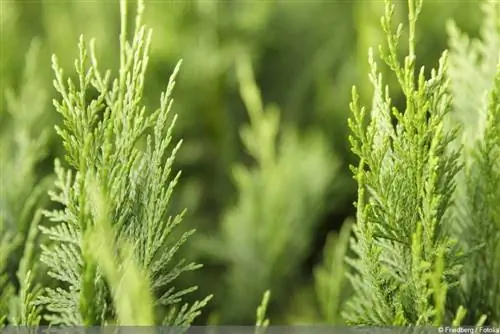- Author admin [email protected].
- Public 2023-12-17 03:39.
- Last modified 2025-06-01 06:48.
It illuminates the garden like a golden glow. The strong, golden yellow flowers attract insects like a magnet with their scent and nectar. The golden sheaf enchants people with its flat, golden yellow flowers. The gray-green and feathery foliage emphasizes this impression in a picturesque way. Yarrow has long been known as a meadow flower. Today it has become an indispensable perennial as a wild perennial plant in natural gardens. It is robust, easy to care for and thrives on poor soils in beds, rockeries and planters.
Peculiarities
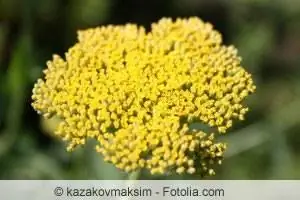
The 'Achillea filipendulina' is hardy and persistent. The stems of this herbaceous perennial are tough and reach heights of 15 to 20 cm. Its flower consists of many small flowers (pseudo umbels). It is a source of food for bees, bumblebees and butterflies, which cannot resist the aromatic scent.
'Achillea filipendulina', the golden yarrow, is the big sister of the common yarrow. It can grow to a height of more than 120 cm. That's why it is also known as Hohe Garbe. It blooms powerfully on its tall stems from June to September. Just like the yarrow, the golden yarrow is used as a medicinal plant due to its active ingredients. Specialists such as doctors and pharmacists know their many possible uses.
Location
The golden sheaf has no special demands on its location. However, it thrives particularly well in locations in sun to full sun. It tolerates heat extremely well. And if the soil is well-drained, dry to fresh, 'Achillea filipendulina' feels completely at home. This undemanding and easy-care wild perennial thrives in the garden and in sufficiently large planters. On sunny balconies as well as on terraces. It tolerates dryness better than too much wetness.
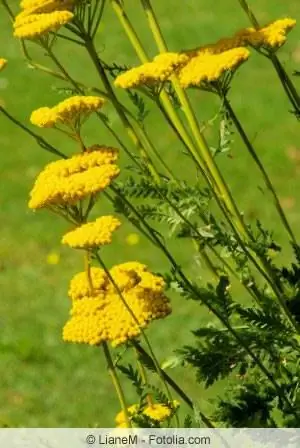
In lush perennial borders, the golden sheaf unfolds its effect in the garden together with roses, lavender, sedum and catnip. With its golden yellow flowers on high stems, it goes just as effectively with meadow flowers such as poppies, daisies or lupines. It is ideal as a cut flower and is suitable as a dried flower. To create a beautiful picture in the bed, three to five plants per square meter are enough. Professional gardeners and hobby gardeners love this robust perennial. The common yarrow 'Achillea millefolium' is mainly found in pure natural gardens. However, the golden sheaf 'Achillea filipendulina' is an expressive partner for wild and magnificent perennials, not only in natural gardens.
It is well known that the golden sheaf likes it sunny and warm. The rock garden or the dry bed are good locations. Their homeland is dry regions with barren soils. A slightly moist soil from spring to autumn is ideal. If the golden sheaf is well rooted, it can cope well with short dry periods. Wet or swampy soil is not suitable for the golden sheaf. The plant is doomed to die.
Care
The golden sheaf is undemanding and does not require much care. Immediately after the first flowering, the stem and flower can be cut back. After pruning, the perennial produces a second flower floret. In autumn to late autumn, the perennial is cut back to 20 cm above the ground. In spring the golden sheaf sprouts again lushly. If the perennials have become too large, dividing the clumps in autumn or spring can help. The golden sheaf takes care of the reproduction all by itself. It simply seeds itself. And so she creates wonderfully overgrown refuges.
The 'Achillea filipendulina' does not necessarily need fertilizer. A small amount of compost in the spring is still good for the golden sheaf. It keeps the perennial he althy and vital. The perennial only needs water on very dry days. Watering is done in the evening or in the morning. Watering should be avoided in the midday sun. Flowers and leaves do not tolerate contact with irrigation water. Contact with the irrigation water damages flowers and leaves. The stems of 'Achillea filipendulina' reach an impressive height of more than 120 cm in the optimal location. They grow upright and clump-like. Their stems become woody from below. Nevertheless, the golden sheaf needs support in strong winds to prevent it from breaking over.
Tip:
Support the plant once the flowers are formed!
Leaves
The leaves of the golden sheaf are deciduous, lush, lanceolate and have a gray-green, almost silvery color. They emit an aromatic scent when touched. The foliage in particular gives the perennial a great effect outside of the flowering period.
Bloom
The golden sheaf 'Achillea filipendulina' lives up to its name with yellow to golden yellow flower umbels. Their flowering period extends from June to September.
Fruit
The fruit of the golden sheaf consists of inconspicuous umbel panicles that adhere to the perennial for a long time.
Special features
- The origin of the perennial lies in the Orient
- Suitable perennial for the farm and natural garden
- popular bee and insect pasture
- Cut off the umbel after flowering to allow for second flowering
- Pinch off the middle flower in favor of many side shoots
- good cut and dried flowers
Popular varieties
- ‘Coronation Gold’ - hybrid variety with golden yellow flowers until November
- ‘Tierra del Fuego’ - bright red umbrella flowers
- 'Parker' - ('Parkerss variety'), golden yellow flowers, stable, very tall growing
- ‘Sulfur blossom’ - sulphur-yellow flowers, medium height
Frequently asked questions
Does the golden sheaf also thrive on loamy soil?
This undemanding perennial thrives on well-drained, sandy and loamy soils. If the clay soil is impermeable to water, gravel must be added to create permeability.
I don't have the time for constant care and control, will the golden sheaf still thrive?
The golden sheaf is one of the really undemanding and easy-care wild perennials. She doesn't value constant care. However, it tends to spread via seeds and roots. She then goes wild. In the right location, however, this is not a flaw, but can create a particularly beautiful picture.
There is a very stony and extremely dry corner on my farm. Can I plant the golden sheaf there?
The golden sheaf in particular copes well with stony, dry ground. The soil needs some compost (a little) so that it is not just rocky. And until the perennial has finally rooted, it always needs slightly moist soil.
What you should know about the golden sheaf in brief
Profile
- Species/Family: Cottage garden perennial, belongs to the daisy family (Asteraceae)
- Care effort: low, easy to care for and robust
- Flowering time: depending on the variety, June to November with 10 to 25 large umbrella- or plate-like inflorescences (pseudo umbels), consisting of numerous small flowers in yellow or red
- Foliage: delicate, depending on the variety, green-greyish, pinnate, fern-like leaves with an aromatic camphor-like scent
- Growth: bushy, upright growth with large clumps of leaves from which the upright flower stalks protrude
- Height/width: 60 to 120 cm high and approx. 90 cm wide
- Location: sunny, warm, nutrient-rich, permeable, rather dry, preferably loamy soil.
- Fertilizer: works well even with fewer nutrients, compost or slow-release fertilizer in the spring
- Planting time: Sow indoors in autumn or directly outdoors in spring
- Pruning: in spring (February) close to the ground, the strong central flower is pinched out to promote side shoot growth; Pruning after flowering promotes re-blooming in autumn
- Partners: blue-blooded plants such as globe thistle, delphinium, sage
- Propagation: by division in autumn or spring
- Overwintering: hardy, but protect from heavy winter wetness
Special features
- comes from the Orient
- typical plant for the cottage garden
- popular bee pasture
- good cut and dried flowers
- can cause allergies if touched

